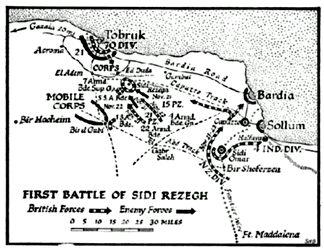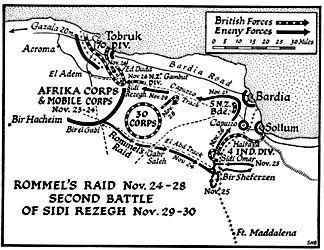The Grand Alliance (114 page)
Read The Grand Alliance Online
Authors: Winston S. Churchill
Tags: #History, #Military, #World War II

The Grand Alliance
687


The Grand Alliance
688
Meanwhile on November 21, the enemy armour being committed to battle, General Cunningham ordered the XIIIth Corps to advance. The 4th Indian Division had already curled round Sidi Omar. On its left the New Zealand Division, under General Freyberg, moved north, and reached the outskirts of Bardia, thus severing the communications of all the frontier garrisons. They captured the headquarters of the Afrika Corps, and on the 23d nearly regained Sidi Rezegh, from which their comrades of the 7th Armoured Division had just been driven. On November 24
Freyberg concentrated the bulk of the New Zealanders five miles to the east of the airfield. On this day therefore our armoured forces were reorganising after their repulse from

The Grand Alliance
689
Sidi Rezegh. The sortie from Tobruk had been launched, and was fighting hard against German infantry, but had not broken through. The New Zealand Division stood before Sidi Rezegh after a triumphant march. The enemy frontier garrisons had been cut off, and their armour, having won its battle against the XXXth Corps, lay to the north of El Gubi.
Very heavy blows and severe losses had been exchanged, and the battle hung in the balance.
No better account can be given of this battle than is contained in General Auchinleck’s final dispatch, which was published in the
Gazette
in 1948.
Since the Panzer divisions now seemed to be committed to battle and were reported to be losing a considerable number of tanks, General Cunningham allowed the signal to be given for the Tobruk sorties to begin and for the XIIIth Corps to start operations. On November 21 however our difficulties began. The enemy, as was to be expected, reacted at once to the threat to Sidi Rezegh, and his armoured divisions evaded the 4th and 22d Armoured Brigades. The whole of the enemy armour then combined to drive us from this vital area and to prevent help reaching the support group and the 7th Armoured Brigade, which were isolated there. Neither of these formations was designed to carry out a prolonged defence, and it is greatly to their credit that they managed to do so, unaided, throughout the 21st. The 5th South African Infantry Brigade, which was expected to reach the scene before the development of the enemy attack, failed to do so, partly owing to the opposition of the Ariete Armoured Division and partly because of inexperience in handling the very large number of vehicles with which it took the field.
Next day all three armoured brigades joined in the defence of the area. But our tanks and anti-tank guns

The Grand Alliance
690
were no match for the German, although they were fought with great gallantry, and on the evening of November 22 the XXXth Corps was compelled to retire, having lost two-thirds of its tanks and leaving the garrison of Tobruk with a huge salient to defend.
The enemy rounded off his success in spectacular fashion. In a night attack he surprised and completely disorganised the 4th Armoured Brigade, whose hundred tanks represented two-thirds of our remaining armoured strength. On
the 23d
he
practically
annihilated the 5th South African Infantry Brigade, one of the only two infantry brigades General Norrie had under command – there was no transport for any more
– and then on the 24th with his armoured divisions he made a powerful counter-stroke to the frontier. Before this it had become quite clear that the first reports had grossly exaggerated enemy tank losses and that he had at least as many tanks as we had and better, and was in a position to recover more from the battlefield, which remained in his hands.
This shifting of the balance of strength between the opposing armoured forces produced a most critical situation….
There was now a dramatic episode which recalls “Jeb”
Stuart’s ride round McClellan in 1862 on the Yorktown Peninsula in the American Civil War. It was however executed with an armoured force which was an army in itself, and whose destruction would have doomed the rest of the Axis army. Rommel resolved to seize the tactical initiative and to force his way eastward to the frontier with his armour in the hope of creating so much chaos and causing so much alarm as to prevail upon our command to give up the struggle and withdraw. He may well have had in his mind the fortune which had rewarded his armoured incursion in the preceding Desert battle of June 15 and led The Grand Alliance
691
to General Messervy’s retreat at the crucial moment. How nearly he succeeded this time will be apparent as the story proceeds.
He collected the greater part of the Afrika Corps, still the most formidable body in the field, and thrust down the El Abd road or track to Sheferzen, narrowly missing the headquarters of the XXXth Corps and two great dumps of supplies, without which we could not have continued the fight. On reaching the frontier he split his force into columns, some of which turned north and south, and others drove on twenty miles into Egyptian territory. He wrought havoc in our rearward areas and captured many prisoners.
His columns however made no impression on the 4th Indian Division. They were pursued by detachments hastily organised from the 7th Armoured Brigade, the support group, and the Guards Brigade. Above all our air force, which had now gained a high degree of mastery in the air above the contending armies, harried him all the time and all the way. Rommel’s columns, virtually unsupported by their own air force, suffered the pangs our troops had known and endured when it was Germany who dominated the battle skies. On the 26th all the enemy’s armour turned northward and sought haven in and near Bardia. Next day they hurried off to the west, back to Sidi Rezegh, whither they were urgently summoned. Rommel’s daring stroke had failed, but, as will now be seen, only one man – the opposing Commander-in-Chief – stopped him.


The Grand Alliance
692
It may be of interest to cite some extracts from the daily telegrams which reached me during this period from Auchinleck and Tedder. On the 21st Auchinleck sent favourable news. “With luck the earth is stopped and the hounds in full cry.” And later in the day: “Engagements between the 22d Armoured Brigade and enemy armoured forces at El Gubi on November 18 heavier than earlier reports showed, and apparently resulted in our losing about forty cruiser tanks, of which many have since been repaired, against estimated enemy losses of fifty-five. Sidi Rezegh is held by the support group of the 7th Armoured Division and the 5th South African Infantry Brigade. Tobruk garrison made its sally this morning. … It is very difficult to

The Grand Alliance
693
arrive at a firm estimate of the enemy tank losses, as the battle has moved and is moving with such great speed…. A marked feature of operations to date has been our complete air supremacy and excellent co-operation between ground and air.” On the 22d he summed up his report: “Prospects of achieving our immediate object, namely, the destruction of the German armoured forces, seem good.” And later: “Spirit and dash shown by commanders and troops have been remarkable. In my opinion Cunningham has so far fought this extremely complicated battle with great skill and daring. … I think much depends on whether a substantial proportion of tanks of the 15th German Armoured Division took part with the 21st Armoured Division in the armoured battles of the last four days, or whether this division is still more or less intact.
